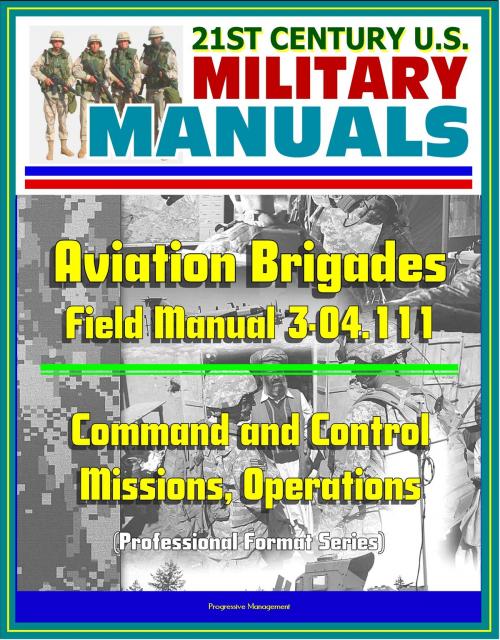21st Century U.S. Military Manuals: Aviation Brigades Field Manual 3-04.111 - Command and Control, Missions, Operations (Professional Format Series)
Nonfiction, History, Military, Aviation| Author: | Progressive Management | ISBN: | 9781301720620 |
| Publisher: | Progressive Management | Publication: | November 17, 2012 |
| Imprint: | Smashwords Edition | Language: | English |
| Author: | Progressive Management |
| ISBN: | 9781301720620 |
| Publisher: | Progressive Management |
| Publication: | November 17, 2012 |
| Imprint: | Smashwords Edition |
| Language: | English |
Professionally converted for accurate flowing-text e-book format reproduction, this field manual (FM) is intended for all aviation commanders, staffs, and any United States (U.S.) military personnel expecting to conduct operations with Army aviation units. The operational concepts described in this manual reinforce fundamental principles found in Army doctrine. It provides overarching doctrinal guidance for employing aviation brigades in full spectrum operations and a foundation for developing tactics, techniques, and procedures (TTP) in other/follow-on Army manuals.
FM 3-04.111 expands employment doctrine for aviation units and describes considerations for forming aviation battalion task forces (ABTFs).
Chapter 1 focuses on aviation brigade organizations and missions and provides aviation brigade fundamentals for reader consideration.
Chapter 2 provides doctrine for organizing operations' command and control (C2) systems. It provides the organization for command post (CP) structure and general guides for roles and functions of CPs and their cells. Chapter 2 also describes duties of brigade leaders and staff.
Chapter 3 discusses employment of the aviation brigade, planning considerations, and air-ground integration.
Chapter 4 focuses on the formation and employment of ABTFs. It provides considerations for task organization based on mission and theater, and discussion of aviation task force employment principles.
Chapter 5 discusses aviation brigade maintenance and logistics providing insight regarding the need to optimize mission accomplishment while balancing sustainability, mobility, and survivability.
This chapter also focuses on the aviation support battalion's (ASB's) mission and function.
The appendices provide guidance, procedures and recommendations concerning specific subjects and amplify concepts referred to in the chapters. Appendix A discusses the Army Force Generation Model. Appendix E provides basic aircraft characteristics.
This FM applies to aviation forces through all operational themes—peacetime military engagements to major combat operations—and full spectrum operations—offensive, defensive, stability, and civil support.
As a bonus, this reproduction includes the complete 2012 Army Leadership manual (FM 6-22), which describes the Army's view of leadership, outlines the levels of leadership (direct, organizational, and strategic), and describes the attributes and core leader competencies across all levels. The principal audience for ADRP 6-22 is all leaders, military and civilian. Trainers and educators throughout the Army will also use this publication. Commanders, staffs, and subordinates ensure their decisions and actions comply with applicable United States, international, and, in some cases, host-nation laws and regulations. Commanders at all levels ensure their Soldiers operate in accordance with the law of war and the rules of engagement. It establishes and describes the leader attributes and core leader competencies that facilitate focused feedback, education, training, and development across all leadership levels. An ideal Army leader has strong intellect, physical presence, professional competence, moral character and serves as a role model. An Army leader is able and willing to act decisively, within the intent and purpose of superior leaders and in the best interest of the organization. Army leaders recognize that organizations, built on mutual trust and confidence, successfully accomplish missions.
Professionally converted for accurate flowing-text e-book format reproduction, this field manual (FM) is intended for all aviation commanders, staffs, and any United States (U.S.) military personnel expecting to conduct operations with Army aviation units. The operational concepts described in this manual reinforce fundamental principles found in Army doctrine. It provides overarching doctrinal guidance for employing aviation brigades in full spectrum operations and a foundation for developing tactics, techniques, and procedures (TTP) in other/follow-on Army manuals.
FM 3-04.111 expands employment doctrine for aviation units and describes considerations for forming aviation battalion task forces (ABTFs).
Chapter 1 focuses on aviation brigade organizations and missions and provides aviation brigade fundamentals for reader consideration.
Chapter 2 provides doctrine for organizing operations' command and control (C2) systems. It provides the organization for command post (CP) structure and general guides for roles and functions of CPs and their cells. Chapter 2 also describes duties of brigade leaders and staff.
Chapter 3 discusses employment of the aviation brigade, planning considerations, and air-ground integration.
Chapter 4 focuses on the formation and employment of ABTFs. It provides considerations for task organization based on mission and theater, and discussion of aviation task force employment principles.
Chapter 5 discusses aviation brigade maintenance and logistics providing insight regarding the need to optimize mission accomplishment while balancing sustainability, mobility, and survivability.
This chapter also focuses on the aviation support battalion's (ASB's) mission and function.
The appendices provide guidance, procedures and recommendations concerning specific subjects and amplify concepts referred to in the chapters. Appendix A discusses the Army Force Generation Model. Appendix E provides basic aircraft characteristics.
This FM applies to aviation forces through all operational themes—peacetime military engagements to major combat operations—and full spectrum operations—offensive, defensive, stability, and civil support.
As a bonus, this reproduction includes the complete 2012 Army Leadership manual (FM 6-22), which describes the Army's view of leadership, outlines the levels of leadership (direct, organizational, and strategic), and describes the attributes and core leader competencies across all levels. The principal audience for ADRP 6-22 is all leaders, military and civilian. Trainers and educators throughout the Army will also use this publication. Commanders, staffs, and subordinates ensure their decisions and actions comply with applicable United States, international, and, in some cases, host-nation laws and regulations. Commanders at all levels ensure their Soldiers operate in accordance with the law of war and the rules of engagement. It establishes and describes the leader attributes and core leader competencies that facilitate focused feedback, education, training, and development across all leadership levels. An ideal Army leader has strong intellect, physical presence, professional competence, moral character and serves as a role model. An Army leader is able and willing to act decisively, within the intent and purpose of superior leaders and in the best interest of the organization. Army leaders recognize that organizations, built on mutual trust and confidence, successfully accomplish missions.















